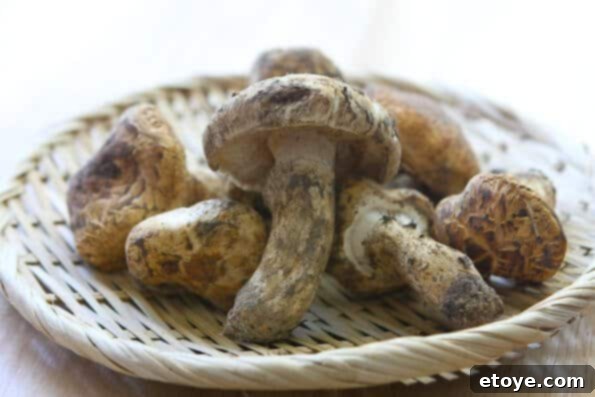
For many food enthusiasts, the original “Iron Chef” series from Japan was a captivating introduction to the world of gourmet ingredients and culinary artistry. While the show was famous for its dramatic battles and theatrical presentations, one particular episode left an indelible mark on my culinary imagination: “Battle Matsutake.” The mere mention of Matsutake Tempura ignited a longing within me for these enigmatic mushrooms, a yearning that persisted for years.
I often heard tales of Matsutake’s elusive nature – a highly seasonal, incredibly rare, and prohibitively expensive delicacy in Japan. This made it feel like a distant dream, something I’d perhaps encounter “one day.” Little did I know, fate had a more immediate plan for me to experience this fungal treasure.
Just a few weeks ago, an exciting revelation changed everything. I discovered that Matsutake mushrooms are also harvested right here in the Pacific Northwest of America! While I’m based in Florida, the thought of these prized mushrooms flourishing on American soil was thrilling. To top it off, this year promised an exceptional abundance. My friend, Dave from Earthy, sent me an email the moment the season began, filled with the promise of fresh Matsutake. I was so tempted to cancel all my travel plans and rush home just to get my hands on these magnificent ‘shrooms.
The next question, of course, was how to prepare them. These aren’t just any mushrooms; their unique aroma demands respectful treatment. Luckily, culinary guidance arrived from two brilliant minds: Marc of No Recipes and Stephan of Zen Can Cook. I’d had the pleasure of dining with both of them in NYC a few months prior, an evening so filled with good food, laughter, and drinks that we entirely forgot to capture a photo!
Their advice was unanimous and profound: when you’re fortunate enough to acquire Matsutake mushrooms, simplicity is key. The mushroom’s fragrance is so distinctively earthy, woody, and almost spicy, that it should be the star. Over-manipulating it with complex flavors would be a disservice. A minimalist approach, combining the Matsutake with a few high-quality ingredients, truly allows its natural aroma and exquisite taste to shine through.
Discovering the Enigmatic Matsutake Mushroom
Autumn marks the treasured season for Matsutake mushrooms. In Japan, these fungi hold an almost mythical status, with prime specimens fetching astronomical prices – sometimes as much as $250 for just six small Matsutake mushrooms! Their value is often compared to that of truffles, not only in cost but in their profound sensory impact. Matsutake boasts a penetrating, deeply earthy aroma that hints at pine forests and a subtle, almost spicy, cinnamon-like undertone. Its texture is notably firm, meaty, and hearty, offering a satisfying bite.
The name “Matsutake” itself offers a clue to its habitat: “Matsu” means pine, and “Take” means mushroom. True to its name, Matsutake thrives exclusively beneath pine trees, forming a symbiotic relationship with their roots. This specificity, coupled with its reputation for never growing in the exact same spot twice, makes it an exceptionally challenging find for mushroom foragers. This unpredictability only adds to its mystique and value, making each successful harvest a triumph.
While Japanese Matsutake (Tricholoma matsutake) is the most famous, other species are found globally, including in North America (often Tricholoma magnivelare). The American Matsutake, though a distinct species, shares the captivating fragrance and delicious flavor profile that makes its Japanese counterpart so revered. It offers a similar sensory experience, bringing the essence of the forest floor directly to your plate.
As food writer Hsiao-Ching Chou eloquently describes, “In that regard, the matsutake resembles the truffle, which lends its perfume to any preparation it encounters. A broth with several slices of a pine mushroom would be served in a lidded bowl or pot, for example, so that the scent of earthy pine with a tinge of cinnamon swirls within the container until it is finally released.” This perfectly encapsulates the Matsutake experience – it’s not just a food item; it’s an aromatic journey.
If you’re eager to experience this culinary marvel, you must act swiftly! Matsutake mushrooms are a fleeting delight, generally available only from September through November. Missing this narrow window means waiting an entire year to savor their unique charm.
Crafting the Perfect Dashi: The Foundation of Dobin Mushi
The preparation of Matsutake Dobin Mushi is an exercise in elegance and restraint, designed to highlight the mushroom’s natural brilliance. The first step involves meticulously cleaning your Matsutake. Gently wipe the mushrooms with a damp cloth to remove any soil, being careful not to bruise their delicate structure. Trim off the tough, fibrous bottom nub of the stem. Then, using a paring knife, turn the blade so you’re using its dull, upper edge to delicately scrape off the thin, outermost layer of the stem. This ensures a clean presentation and tender texture.
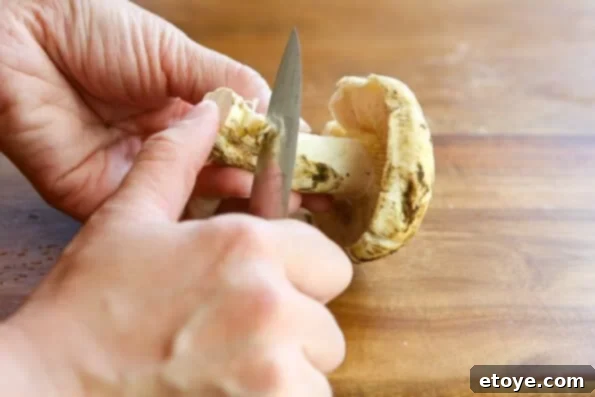
Here you can see the beautifully cleaned and trimmed Matsutake mushrooms, prepared for their starring role.
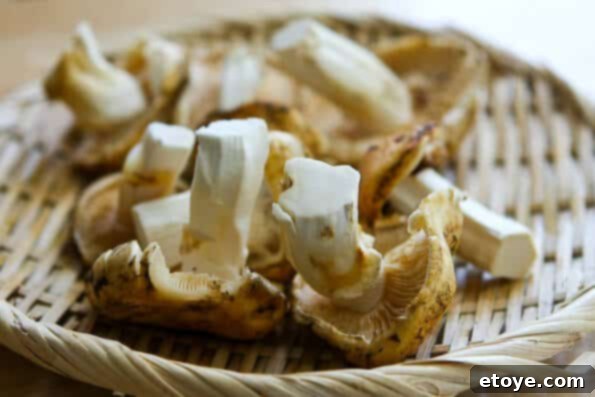
Central to Dobin Mushi, and indeed much of Japanese cuisine, is dashi – a delicate, umami-rich broth. Making dashi from scratch is surprisingly simple and requires just three core ingredients: water, bonito flakes (katsuobushi), and dried kelp (kombu). The depth of flavor these simple components yield is truly remarkable.
For authentic dashi, opt for large bonito flakes, also known as katsuobushi. You’ll find them in sizable packages at most Asian markets. Distinguish them from the smaller flakes, which are typically used for garnishing. The ideal bonito flakes should be roughly the size and delicate texture of a cornflake – light, airy, and almost translucent.

Observe the exquisite beauty of these bonito fish flakes! Their ethereal lightness and flakiness are captivating. A word of caution: handle them gently, and be mindful not to sneeze – they’re incredibly delicate!
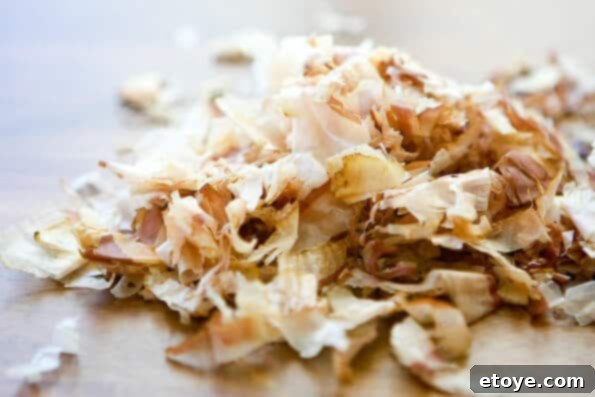
The other crucial component for dashi is dried kelp, or kombu. You’ll need about a 6-inch piece for this recipe. Kombu contributes a different kind of umami – a deeper, more oceanic savory note that perfectly complements the smokiness of the bonito.

Kombu often comes in long, dried sheets, sometimes folded. For dashi, you only need a single layer. Simply break off a 6-inch section. It’s important to note that the white powdery substance on kombu is not dirt; it’s naturally occurring glutamates, the source of its umami. Do not rinse or soak the kombu extensively, as this washes away the very essence of its flavor. Instead, a light wipe with a damp cloth is sufficient to remove any surface dust.

Once wiped, place the kombu into a pot with water and heat it over medium-low flame. The goal is to gently extract its flavors. As the water approaches a gentle simmer – look for tiny bubbles beginning to form around the edges – remove the kombu just before it boils. Boiling kombu can release bitter notes, which we want to avoid for a clean, delicate dashi.
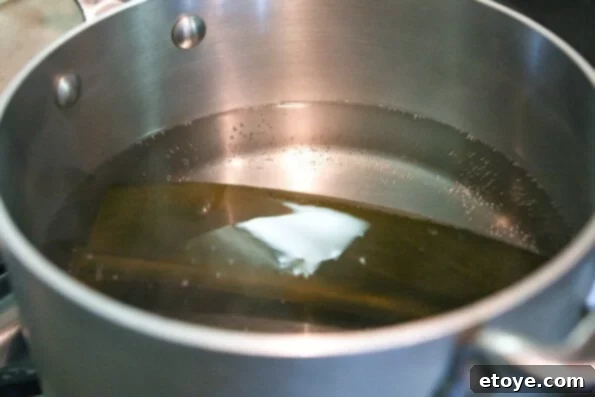
Immediately after removing the kombu, add two generous handfuls of bonito flakes to the hot water. Stir them gently and, crucially, turn off the heat at once. Allow the bonito flakes to steep briefly in the hot water. As they absorb the liquid, they will slowly sink to the bottom, infusing the broth with their distinctive smoky and savory notes.

Once the flakes have settled, carefully strain the dashi through a fine-mesh sieve or cheesecloth. Resist the urge to press or squeeze the bonito flakes, as this can introduce cloudiness and undesirable bitter flavors into your pristine broth. The result is a clear, golden liquid – your perfectly crafted dashi, ready to elevate any Japanese dish.

Don’t discard the used kombu! It still holds residual flavor and can be repurposed. Simply rinse it gently under cold water, pat it dry, and allow it to air dry completely on your countertop. Once thoroughly dry, you can store it in your pantry and reuse it for a second, lighter batch of dashi (known as “niban dashi”) or incorporate it into other dishes like braises or pickles, minimizing waste and maximizing flavor.

A perfectly dried piece of kombu, ready for another culinary adventure.

The Art of Matsutake Dobin Mushi: Steaming Perfection
Now, with our exquisite dashi prepared, it’s time to assemble the Dobin Mushi. This traditional Japanese dish is typically served in a specialized teapot (dobin) and steamed, allowing the ingredients to gently cook and their flavors to meld harmoniously without aggressive boiling. Begin by carefully ladling the strained dashi into your teapot.
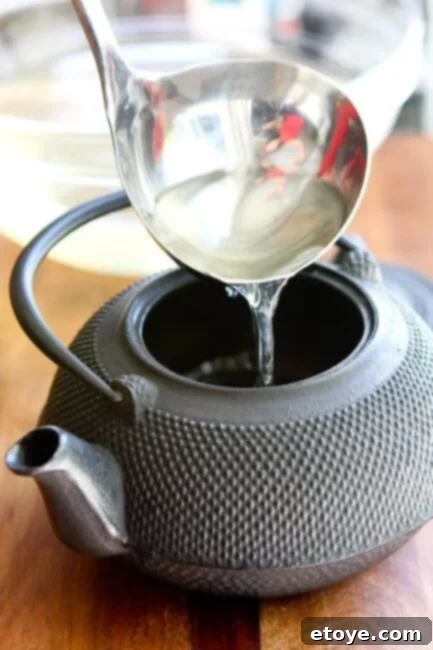
Next, introduce the star ingredients. For this Matsutake Dobin Mushi, I used thinly sliced fresh fish, delicate carrot slices, and of course, the prized Matsutake mushrooms, also thinly sliced. The beauty of Dobin Mushi lies in its versatility; while Matsutake is paramount here, you can customize the other additions. I’ve successfully made it with tender chicken, succulent shrimp, and even ginko nuts, each offering a unique textural and flavor dimension. The choice is yours, limited only by your imagination and the seasonal availability of ingredients. Further down, you’ll find a curated list of links to various Dobin Mushi recipes for inspiration.
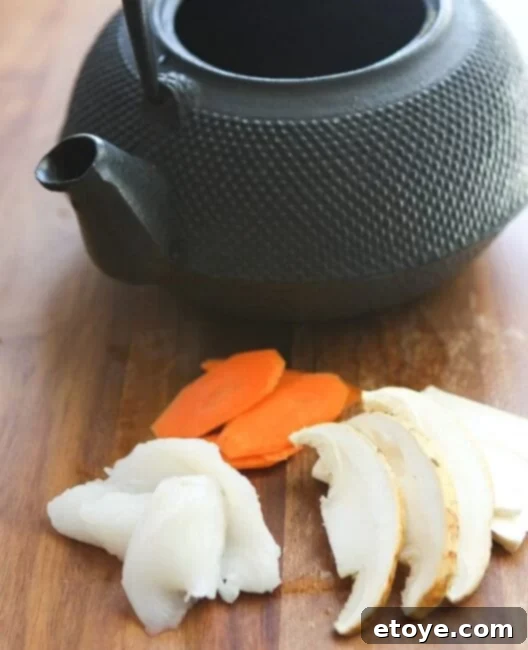
Once all your chosen ingredients are nestled in the teapot, enhance the broth with a tablespoon of good quality Japanese sake, a splash of premium Japanese soy sauce for depth, and a tiny sliver of fresh lime peel. The lime peel, though subtle, adds a bright, zesty note that beautifully complements the earthy Matsutake and the savory dashi.
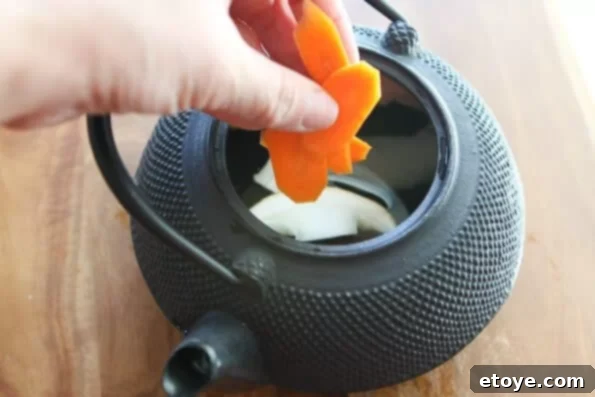
Unlike a direct stovetop simmer, Dobin Mushi is cooked by steaming. This gentle method ensures the ingredients retain their delicate textures and flavors, preventing them from overcooking and allowing the broth to infuse slowly with their essences. I typically use a large wok with a steamer stand inserted. Fill the wok with water and bring it to a rolling boil, creating a consistent source of steam.

Carefully place the teapot, filled with its precious contents, onto the steamer rack within the wok. Ensure it’s stable and securely positioned.

Cover the wok with its lid, sealing in the steam. This allows the heat to circulate evenly around the teapot, gently cooking the ingredients and coaxing out their exquisite flavors into the dashi broth.
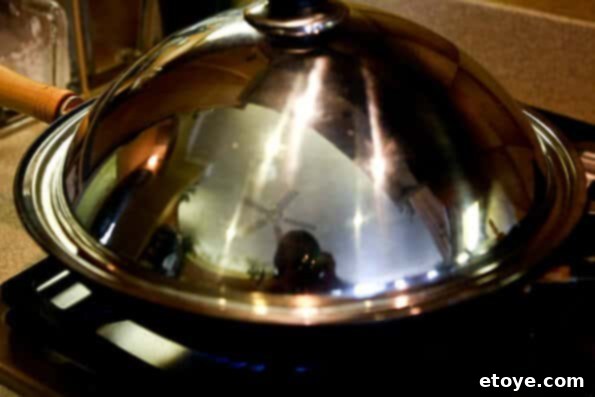
Steam for approximately 8 minutes. The exact time may vary slightly depending on your ingredients and steamer, but this duration is generally sufficient for the Matsutake and fish to cook through and for their flavors to meld beautifully with the dashi.
The Matsutake Dobin Mushi Experience
The moment of serving Dobin Mushi is a ritual in itself. Traditionally, the aromatic broth is poured directly from the teapot’s spout into a small, delicate teacup. This allows you to first savor the pure, fragrant essence of the broth, imbued with the rich umami of dashi and the intoxicating perfume of Matsutake. It’s a moment of quiet contemplation, a taste of autumn’s bounty.
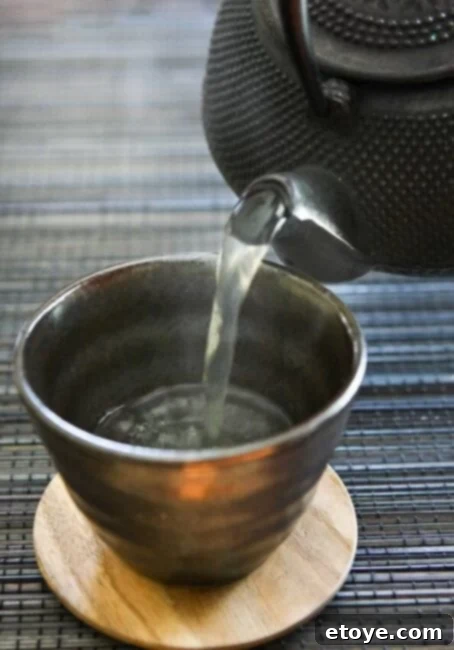
After enjoying the initial sips of the sublime broth, you can then delve into the teapot itself to discover the delectable “goodies” within. The cooked Matsutake slices, tender fish, and sweet carrots offer a delightful textural contrast to the broth, each bite a testament to the dish’s elegant simplicity.

It’s like a culinary treasure hunt, each spoonful revealing another delicate morsel of flavor and texture, all infused with the unforgettable essence of the Matsutake mushroom. This humble yet sophisticated dish truly embodies the Japanese culinary philosophy of highlighting natural ingredients with respectful preparation.
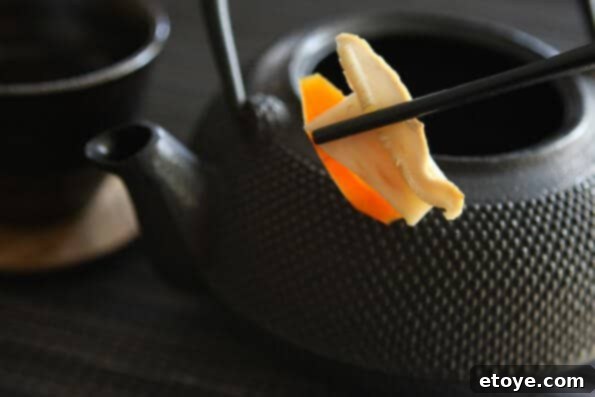
Authentic Matsutake Mushroom Dobin Mushi Recipe
This exquisite Dobin Mushi recipe is designed to celebrate the unique flavor and aroma of Matsutake mushrooms. While traditionally served in a dobin teapot, you can easily adapt this dish using common kitchenware. If you don’t have a wok or a specialized teapot, a large, wide stockpot or Dutch oven combined with individual ramekins or heatproof bowls will work perfectly for steaming. Simply divide the solid ingredients among the ramekins, cover each with a parchment paper circle (or a small piece of tin foil), and arrange them on a steamer rack inside your large pot. Should you lack a steamer rack, an inverted shallow bowl or a few inverted shot glasses can serve as an improvised platform to elevate your ramekins above the simmering water.
Remember, the Matsutake mushroom is the undisputed star of this dish. Keep the accompanying ingredients minimal and light to ensure its unparalleled fragrance and earthy notes remain at the forefront. The Matsutake mushrooms for this recipe were generously provided by Earthy.com, a fantastic source for high-quality, seasonal produce.
Serves 2 as part of a multi-course meal.
For the Umami-Rich Dashi
4 cups filtered water
6-inch piece high-quality kombu (dried kelp)
2 generous handfuls of katsuobushi (large bonito flakes), approximately 2 cups loosely packed
For the Matsutake Dobin Mushi
2 fresh Matsutake mushrooms, cleaned and thinly sliced (about 2 ounces)
A few slices of delicate white fish (e.g., snapper, cod, or sea bream), about 2 ounces
A few very thin slices of carrot (from about 1/4 of a medium carrot)
1 tablespoon premium quality Japanese sake (drinking sake)
1 tablespoon high-quality Japanese soy sauce
A tiny sliver of fresh lime peel (about 1/4 inch by 1/2 inch)
Instructions:
1. Prepare the Dashi: Place the kombu into a medium-sized pot with the 4 cups of filtered water. Allow the kombu to soak for at least 10 minutes to begin releasing its flavors. Turn the heat to low-medium. Gently heat the water, watching carefully. Just as tiny bubbles begin to form around the edges of the pot (before a full boil), remove the kombu. Immediately add the two handfuls of katsuobushi (bonito flakes) to the hot water. Stir gently, then turn off the heat immediately. Do not allow the dashi to boil vigorously once bonito flakes are added, as this can create bitter flavors. Let the mixture sit undisturbed until the bonito flakes have sunk to the bottom, typically 5-10 minutes. Carefully strain the dashi through a fine-mesh sieve or cheesecloth into a clean bowl or container. Avoid pressing or squeezing the bonito flakes, as this will result in a cloudy broth with a harsher taste. Reserve the clear dashi stock.
2. Prepare the Matsutake and Assemble: Clean the Matsutake mushrooms meticulously. Use a damp terry cloth to gently wipe any dirt off the caps and stems. Using the dull, backside of a paring knife, carefully scrape off the thin, outer layer of the mushroom stems. Trim and discard the tough, fibrous bottom portion of the stems. Ladle the prepared dashi into your dobin teapot (or individual ramekins if using). Add the thinly sliced Matsutake mushrooms, white fish slices, and carrot slices. Pour in the Japanese sake and soy sauce, and add the small sliver of lime peel. Stir gently to combine the ingredients.
3. Steam the Dobin Mushi: Set up your steaming apparatus as described above or as shown in the accompanying photos. Bring the water in your wok or stockpot to a boil. Carefully place the teapot (or ramekins) onto the steamer rack. Cover the wok with its lid, ensuring a tight seal to trap the steam effectively. Steam on medium-low heat for approximately 7 minutes. If you are incorporating heartier ingredients like chicken, you may need to steam for an additional 2-3 minutes. Serve immediately, first pouring the fragrant broth into a small teacup, then enjoying the delicate ingredients from the pot.
Explore More Matsutake Delights and Resources
Eager to learn more about these extraordinary mushrooms or find additional Matsutake recipes? Here are some excellent resources:
- Discover Fresh Matsutake Mushrooms from Earthy.com
- A Fantastic Forage: Insights into Matsutake
- Kinoko Dobin Mushi: A Recipe to Savor the Autumn
- Another Delicious Matsutake Dobin Mushi Recipe
- Mad About Matsutake: A Local Perspective
- An Introduction to the World of Matsutake
- Go Wild About Matsutake: Culinary Tips
- Hunting for Matsutake Mushrooms: A Glimpse into Their Habitat